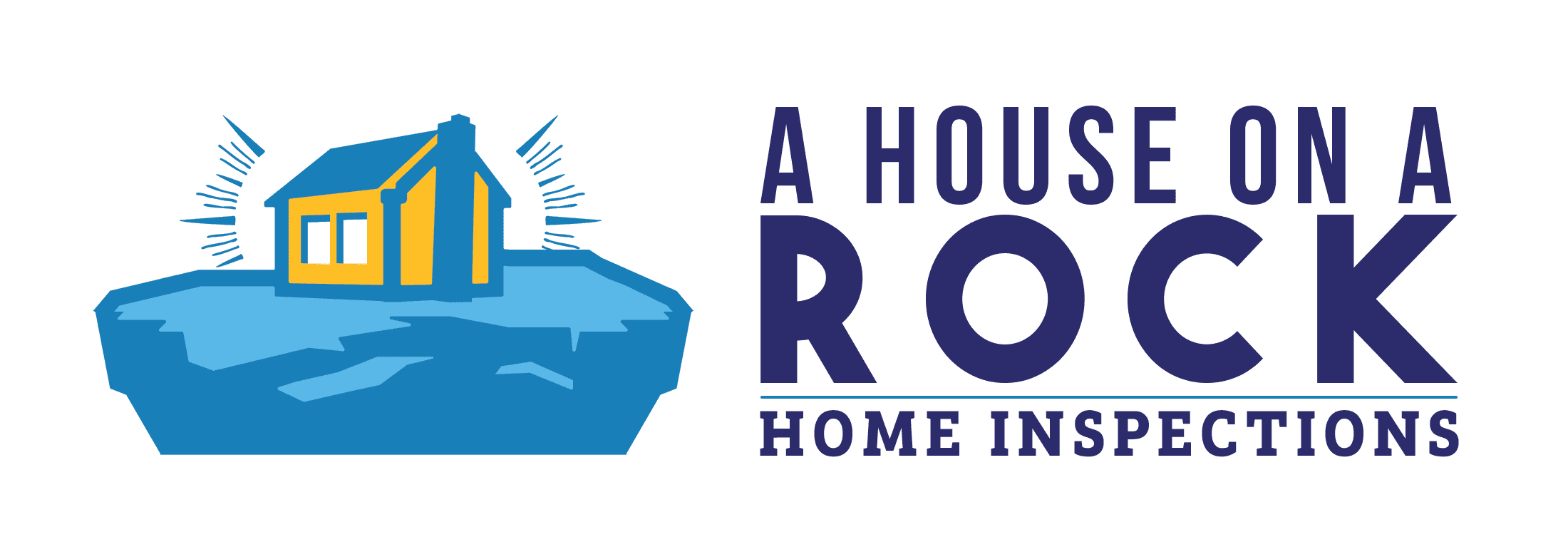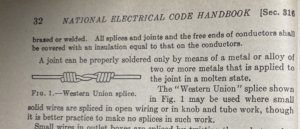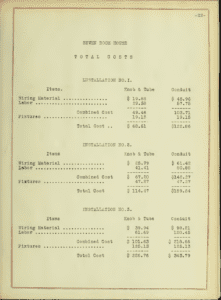Five Fascinating Facts about Knob and Tube
I am totally a house geek. In fact, I own several historic code books, and I enjoy internet sleuthing all things houses. Naturally, I enjoy writing my own articles for others. Click here to go down past the cool stuff and learn what is knob and tube wiring anyway.
1.
First, knob and tube wiring actually only referred to the two wire system that was concealed. Knob and tube wiring that was exposed was referred to in the NEC (National Electrical Code) as open wiring on insulators.
Chapter 2 in the 1947 defines Open Wiring on insulators as
“Conductors for open wiring must be rubber-covered, thermoplastic, slow-burning, or asbestos-covered. The conductors are secured to and supported by insulators, usually of porcelain, though glass and various composition materials are used to some extent. It is seldom used for branch-circuit wiring except in unfinished basements and attics of wood-frame construction buildings where the concealed wiring is knob and tube work.
Knob and Tube work. This is the concealed type corresponding to open wiring on insulators..
So, “Open wiring on insulators” is the exposed type and knob and tube is the concealed type.
2.
Second, some knob and tube contains asbestos. Given the potential for fire, open wiring was limited to types that were heat, or fire resistant. This included rubber insulated, Slow-burning, or asbestos – varnished – cambric. Cambic is essentially the black cotton cloth around the wire and it was embedded with asbestos.
3.
Third, knob and tube splices were not required to be made in boxes. Specifically, the NEC suggested that “it is better practice to make no splices” in K&t wiring. However, they allowed splices such as the “Western Union Splice” to be soldered and taped.
4.
Fourth, open wiring, and Knob and tube wiring was not approved in the following locations: theatres, motion-picture studios, commercial garages, and any hazardous location.
Commercial garages and hazardous locations makes sense. It took a little more digging to determine why knob and tube was not allowed in theatres and motion picture studios.
Before 1950 most film contained nitrate. Nitrate is highly flammable and theatre fires became a very real and common problem. In fact, the film booth itself had specific requirements. Only the electrical equipment and devices which was absolutely necessary to be in the booth was allowed in the booth. Switches, overcurrent protection devices and other equipment were not allowed in the booth.
This would presumably be to prevent sparks in the booth. This is similar to how modern code prohibits ignition devices within 18 inches of a residential garage floor.
5.
Lastly, conduit wiring existed Since at least 1912.
I could not find an exact date for when conduit wiring was invented, but I found at least one reference to conduit wiring being used since at least 1912. That means for most of the duration that k&t systems were installed, there were safer alternatives. However, conduit wiring was twice as expensive in materials and labor, and k&t was often chosen for its price.
If you want to check out this full estimate from 1912 here is the link.
Not Even Sure what Knob and Tube is? Read on
What is Knob and Tube?
Knob and tube wiring is a wiring system that is found in older homes (built in the late 1800’s to about 1940). It consisted of two wires (copper wire)- one hot wire, and neutral wire. The wires were insulated with varying types of insulation, such as rubber insulation, or asbestos treated cotton insulation.
Electricity is inherently a fire hazard, especially in timber homes. To reduce the chance of fire, knob and tube wires were insulated from the wood framing and other combustibles with knobs and tubes.
Glass or porcelain knobs, or ceramic knobs were used to suspend the wires at least 1/2 inch from the surface of the wood. The knobs were also referred to as cleats.
Where the electrical wires passed through framing, ceramic tubes were used to insulated the wires from the wood framing.
As stated, knob and tube consisted of two wires, the live wires, and the neutral wires. These systems, just like most older electrical systems, did not have ground wires. Ground wiring code requirements did not begin until 1956, and were not required on all circuits until 1962. This lack of a ground wire is the most significant con of k&t systems.
What is the Ground Wire For?
The ground wire bonds all metal non current carrying components together and back to the main panel. In the event of ground faults, this wire carries the flow of electricity back to main panel allowing the circuit breaker to trip.
Without a ground wire present, non current carrying metal components, such as the metal frame of an appliance, will hold current during a fault, until it becomes grounded. If a homeowner touches the frame, and is grounded, the electricity will flow through them. Obviously, this is also known as an electrical shock.
Is Knob and Tube Safe?
Insurance companies and home inspectors tend to insist that knob and tube wiring is unsafe. However, there is nothing inherently more unsafe about knob and tube wiring than any other electricity in the home. The mere fact that it is an old wiring system does not make it unsafe.
We already talked about the the lack of a ground wire. It’s important to realize that this makes it less safe than if it had a ground wire, but not UNSAFE.
There are two common issues regarding the safety of knob and tube wiring. First, is electrical work done by homeowners and amateurs. Second is home insulation added around the wires.
For example, an older house, built in the early 1900s did not have as many electrical outlets or light fixtures. Over the last 100 years it is likely that considerable upgrades have been made to the home’s electrical system.
Unfortunately, many homeowners improperly splice, and otherwise modify the system creating safety hazards. In other words it is not he original installation that is a safety hazard, it is the improper new wiring that is the safety hazard.
The other problem is when the wiring has insulation installed over it. There are many professionals who argue that insulation installed over knob and tube in good shape poses no hazard. Regardless, it has been a violation of the national electrical code since 1987 to do so.
The theory is that the wires relied on the free air, or open air around the wires to dissipate heat. The addition of insulation around the wires causes excessive heat and fires. True, or not, it is unlikely the code will ever change, and that is what we must work with.
Will a Home Inspector Find Defects With Knob and Tube?
Maybe.
Unfortunately, most home inspectors are already under the false notion that knob and tube is just unsafe, and they will just recommend replacement without inspecting it.
Even still, a home inspection is only going to inspected a limited amount of the k&t wiring. They are only going be able to inspect what is visible at the time of inspection such as wiring in the attic (if not covered with insulation), on exposed basement floor joists, or in the electrical panel.
Any wiring hidden in the walls, floors, or any such spaces will not be inspected.
Even if the wiring is in good shape, and it hasn’t been touched, it is still probably a good idea to replace it. The fact that you can not insulate over it is reason enough. Insulation and air conditioners were not in use when the knob and tube was installed and comfort and energy costs were not considered.
The only way to insulate the attic and wall cavities of an older home is to replace the wiring.
If you want insurance coverage on your home, which is generally required anyway, you are going to need to upgrade to modern wiring.
Any defects with knob and tube can be repaired, and new wiring can be added for modern appliances, but the inability to insulate your house, or insure your house are pretty sound reasons to replace knob and tube.
Click here to add your own text






